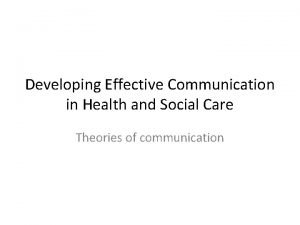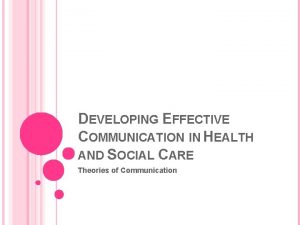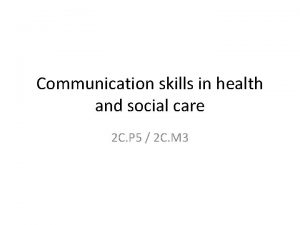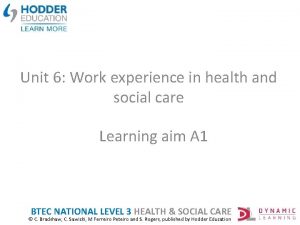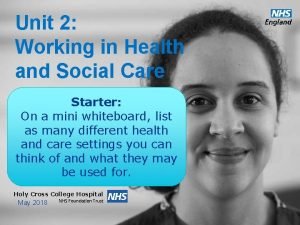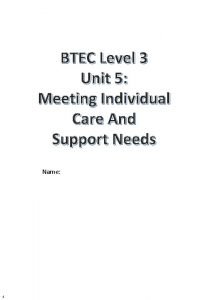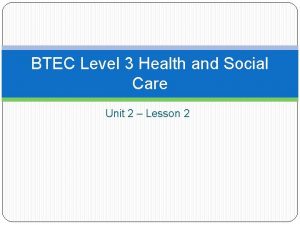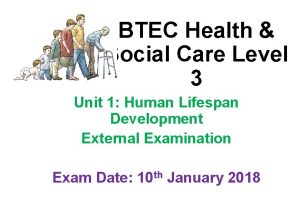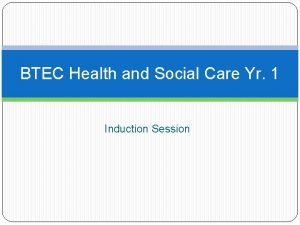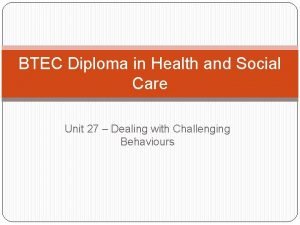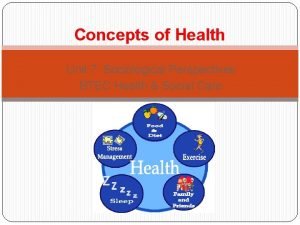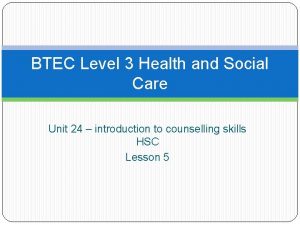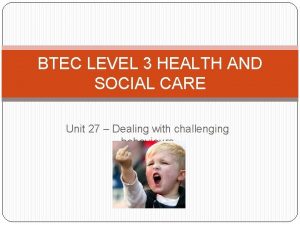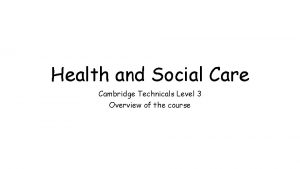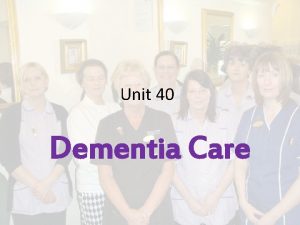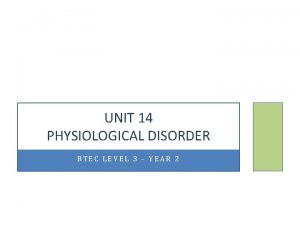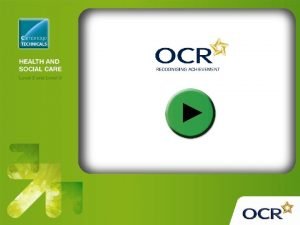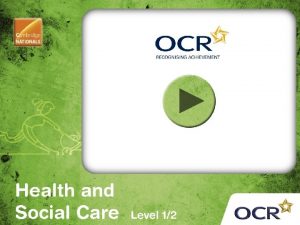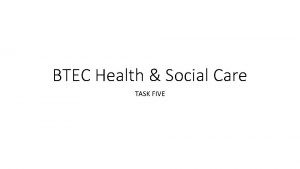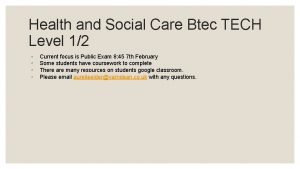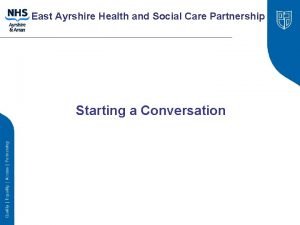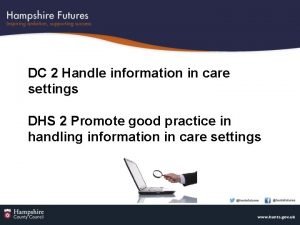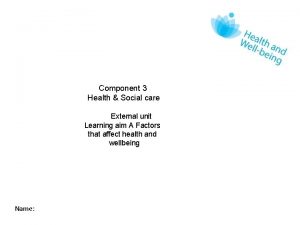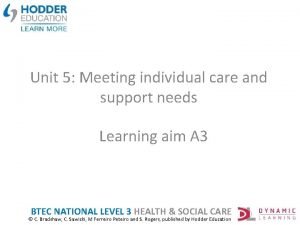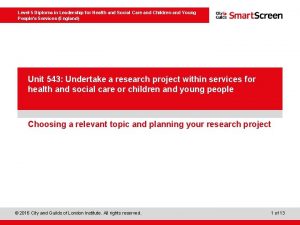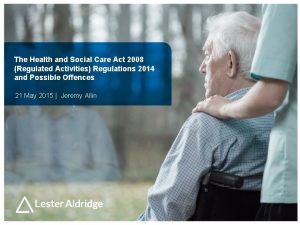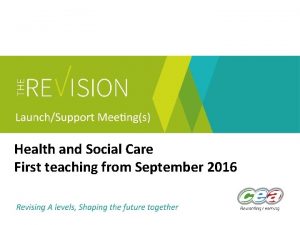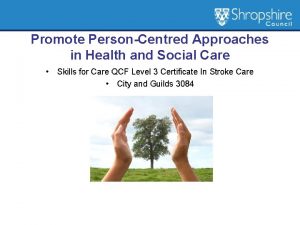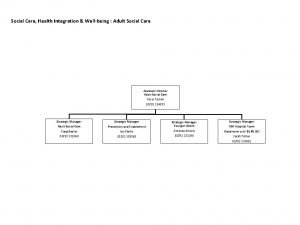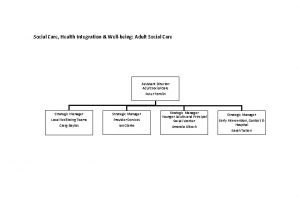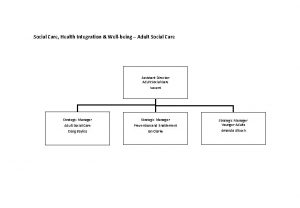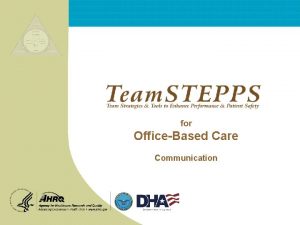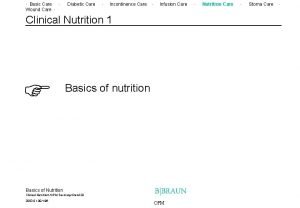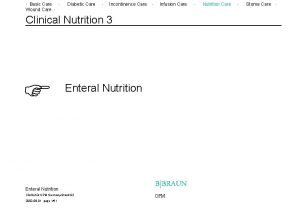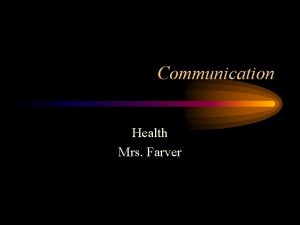Unit 51 Promote Communication in Health Social Care









































- Slides: 41

Unit 51 Promote Communication in Health, Social Care or Children’s and Young People’s Settings

Outcome 1 Understand why effective communication is important in the work setting 1. 1 Identify the different reasons people communicate

Reasons why people communicate: To To To build relationships maintain relationships share ideas and thoughts express needs and feelings gain and share information gain reassurance and acknowledgement

1. 2 Explain how communication affects relationships in the work setting. Sharing and gaining information Settling in Supporting children’s play and learning Transitions Effective teams

Outcome 2 Be able to meet the communication and language needs, wishes and preferences of individuals 2. 1 Demonstrate how to establish the communication and language needs, wishes and preferences of individuals

Fawlty Towers Communication Difficulties http: //www. youtube. com/watch? v=TIVDx 8 k. WZo The Two Ronnies Bad Communication http: //www. youtube. com/watch? v=Pcdg 6 l 7 Fc q. E As you can see some may need you to look at them so that they can lip read or someone else may need communication to take place at a slower speed.

Tips: Use positive body language and facial expressions Know their name – what would they like to be addressed as? Ask directly e. g. “do you speak English? ” Do not rush them Parents will be able to help with tips e. g for a child who is deaf touch the child to draw his attention; let him see your lips and actions

2. 2 Describe the factors to consider when promoting effective communication Ways in which we communicate Environment Proximity, orientation and posture Listening skills Time

Ways in which we communicate: Face to face interactions Conversations where both people can respond quickly Useful for sharing and giving information. You can see person’s reaction May not be good for conveying complex information that someone needs time to consider or see written down

Phone Conversation when someone is not available to speak face to face Choice of words and tone become very important Can be hard to assess if the other person has understood your meaning In some situations notes from a phone call may need to be taken and a record made

Sign Language A language that allows a deaf person to communicate British Sign Language is a recognised language and allows someone to communicate fully

Makaton Gestures that support the spoken word. Used to help children and adults who find it hard to understand or process the spoken word. Needs to be used with clear speech and strong facial expression. Users may develop their own variations of the signs and so getting to know ‘their style’ can be helpful.

Letters and Memos Written way of conveying information or sending messages Useful as it allows time to absorb information. Likely to be kept Style and tone has to be thought about to avoid misunderstandings

Emails Electronic way of sending notes and letters Useful if a more relaxed style is needed Be aware that not everyone will have access to a computer or will store/print out emails.

Reports A formal way of presenting information Useful for providing information that has to be structured and ‘professional’ Reports need to be accurate and should be dated Language needs to be formal which may be a barrier for some parents

Visual images including pictures and photographs Visual images can aid understanding. Visual images can help babies and young children to communicate but also understand what we are saying.

Audio/visual recordings Used so that parents and others can ‘see’ or ‘hear’ children in action. Provides a way of sharing information.

Environment Much more difficult to exchange personal information in busy, noisy environments For parents and young people we may sometimes require a quiet place whereas for toddlers and young children we may need to create cosy and homely places.

Proximity, orientation and posture Proximity – is the distance between you and the person you are communicating with. Children who do not know you or who are shy may be intimidated. Be aware of cultural differences. Be observant and notice whether someone tries to move back a little from you or seems to need to be closer.

Orientation – relates to your body’s position. If you are directly opposite someone, it sends out different signals from if you are to the side of them. Being slightly at an angle when communicating with an adult can also be helpful, as it means that either of you can break off eye contact and it allows the communicating style to be less direct.

Posture – Are you giving out ‘bored’ signals or ‘interested’ ones. Leaning forward slightly in a chair shows that you are interested. Leaning backwards may make the other person think you are bored.

Time Both adults and children need opportunities to think about how to respond in a conversation and also what they wish to communicate. Vital particularly when communicating with young children, but also if giving adults information that is complex or unexpected.

Listening Skills ‘Active listening’ Give your full attention to the other person Focus on not just what they are saying but how they say it Essential when encouraging young children’s speech and also when dealing with potentially difficult situations with other adults

2. 3 Demonstrate a range of communication methods and styles to meet individual needs Communication methods include: A - non-verbal communication, e. g. • eye contact • touch • physical gestures • body language • behaviour. B - verbal communication, e. g. • vocabulary • linguistic tone • pitch.

Communication http: //www. youtube. com/watch? v=vp. PX 70 V_ z. IY Activity: Make a list of positive/negative body language and physical gestures

2. 4 Demonstrate how to respond to an individual’s reactions when communicating. Monitor the reactions of others in order to adjust own body language, facial expression and tone of voice N. B. Ignoring reactions to what we have said is not an option

Outcome 3 Be able to overcome barriers to communication 3. 1 Explain how people from different backgrounds may use and/or interpret communication methods in different ways Research activity on computer

Gestures, meanings and cultures http: //www. youtube. com/watch? v=f. RQSRed 5 8 XM

3. 2 Identify barriers to effective communication Activity: 1) In pairs, think of as many barriers to effective communication as you can 2) How would you overcome these barriers? (use grid sheet)

Cultural – eye contact/different meanings/language Hearing/sight impairment Lack of confidence/personality Additional needs - vocabulary Speech and language difficulties Strong accents Literacy ICT knowledge

Overcoming barriers: Time Speaking clearly Do not make assumptions Adapting the environment Translators/interpreters Visual aids Sign language/Braille Change method of communication

3. 4 Demonstrategies that can be used to clarify misunderstandings

Modifying or changing our tone/style Changing the medium of communication Checking understanding Simplifying language Using visual aids Apology Willingness to listen to others

3. 5 Explain how to access extra support or services to enable individuals to communicate effectively. Services may include: • translation services • interpreting services • speech and language services • advocacy services Activity: Research on computer Give an explanation of what each service does and find out how to access them.

Outcome 4 Be able to apply principles and practices relating to Confidentiality

4. 1 Explain the meaning of the term confidentiality

Confidentiality means having another's trust or confidence being entrusted with secrets or private affairs. It also refers to ensuring that particular information is accessible only to those authorized to have access to it.

Data Protection Act 1998 When handling, collecting, processing or storing personal data, ensure that the personal data: is accurate and up to date is deleted/destroyed when it is no longer needed is kept secure at all times

Activity: Which information would you consider confidential at your setting? (personal/sensitive information) Make a list

4. 2 Demonstrate ways to maintain confidentiality in day to day communication How do you do this at your settings?

4. 3 Describe the potential tension between maintaining an individual’s confidentiality and disclosing concerns. Activity Worksheet
 Care value base health and social care
Care value base health and social care Health and social care component 3
Health and social care component 3 Argyle theory of communication in health and social care
Argyle theory of communication in health and social care Theories of communication in health and social care
Theories of communication in health and social care Observation skills in health and social care
Observation skills in health and social care Health and social care level 3 unit 6
Health and social care level 3 unit 6 Health and social care unit 2
Health and social care unit 2 Working in health and social care unit 2
Working in health and social care unit 2 Health and social care unit 14 coursework
Health and social care unit 14 coursework Btec health and social care unit 5 coursework
Btec health and social care unit 5 coursework Health and social care unit 2
Health and social care unit 2 Unit 12 health and social care level 3
Unit 12 health and social care level 3 Unit 5 health and social care assignment
Unit 5 health and social care assignment Unit 27 health and social care
Unit 27 health and social care Unit 14 physiological disorders assignment 2
Unit 14 physiological disorders assignment 2 Unit 7 health and social care
Unit 7 health and social care Unit 24 health and social care
Unit 24 health and social care Btec level 3 health and social care unit 4
Btec level 3 health and social care unit 4 Cambridge technicals level 3 health and social care unit 2
Cambridge technicals level 3 health and social care unit 2 Unit 40 dementia care
Unit 40 dementia care Unit 14 health and social care assignment
Unit 14 health and social care assignment Protect, promote, and improve the health of all people
Protect, promote, and improve the health of all people Primary secondary tertiary care definition
Primary secondary tertiary care definition Pearson btec level 3 national extended diploma
Pearson btec level 3 national extended diploma Ocr health and social care level 2
Ocr health and social care level 2 Cambridge national health and social care
Cambridge national health and social care Robert vischer empathy theory disadvantages
Robert vischer empathy theory disadvantages Kerry murray
Kerry murray Ocr cambridge national health and social care
Ocr cambridge national health and social care Gm health and social care partnership
Gm health and social care partnership What is intellectual in health and social care
What is intellectual in health and social care Health and social care component 1 coursework example
Health and social care component 1 coursework example East ayrshire health and social care partnership
East ayrshire health and social care partnership Data protection act in health and social care settings
Data protection act in health and social care settings Health and social care component 2 learning aim b example
Health and social care component 2 learning aim b example Verna case study
Verna case study Unit 5 meeting individual care and support needs
Unit 5 meeting individual care and support needs Level 5 health and social care research project examples
Level 5 health and social care research project examples Health and safety social care act 2008
Health and safety social care act 2008 Health and social care act 2008
Health and social care act 2008 Ocr cambridge nationals health and social care
Ocr cambridge nationals health and social care Ccea gce health and social care
Ccea gce health and social care


